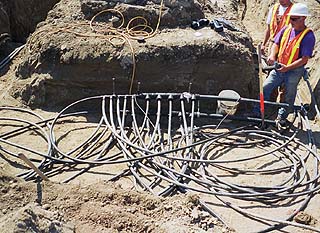
DJC.COM
March 17, 2005
Seattle schools offer lessons in green
Heery International

Photo courtesy of Heery International
Crews at Madison Middle School in West Seattle installed a geothermal heating and cooling system, the first for the Seattle School District. USK Corp. was the general contractor for the first phase of the project. Garco Construction will complete the second phase.
|
Seeing is believing. But there's also much more than meets the eye where Seattle Public School's Building Excellence capital program is concerned.
New schools and renovation projects that restore historic facilities to their original splendor are certainly easy to see. Not quite as apparent is the array of sustainable elements that are incorporated into the district's building program.
Examples include the recycling and reuse of construction materials, the installation of products such as low-gas-emitting carpet and the use of bioswales, geothermal heating and cooling systems.
"As a member of this community, I believe we all need to be concerned about leaving our environment better than we found it," says School Board President Brita Butler-Wall.
"As a policy-maker, I believe we need to make sure our school facilities help protect the environment and our children learn how to be good stewards of the environment."
School officials also recognize the need to be good stewards of public dollars.
"The district's goal is to follow sustainable practices to meet standards set for high-performing schools," says Don Gillmore, the district's program manager. "We implement practices that are both practical and reasonable."
The school district has been recycling and reusing construction waste and building materials for 10 years. Old brick from a demolished wing, for example, is being used at Madison Middle School.
Another practice the district follows is to commission its buildings to ensure that their systems work efficiently.
"Seattle City Schools was one of the first districts in the state to incorporate commissioning into its building program," says Bruce Herr, vice president of Heery International, the Building Excellence program manager.
Madison Middle School
Madison Middle School has headed underground in its quest for efficient energy.
The building, slated to reopen in the fall, is the school district's first to incorporate a geothermal heating and cooling system.
"We dug 173 wells under the sports field," says Steven Moore, a Heery project manager. "Heating and cooling will be provided courtesy of the earth geothermal systems, (and) require no combustion, no fuel storage and delivery, and produce no indoor pollutants."
Geothermal systems require minimal maintenance because there's less equipment to maintain. While the systems initially cost $125,000 more than traditional heat/chill pumps, Gillmore expects the school to earn that money back in eight years. After that, the school should see energy savings of $15,000 per year.
"The site was perfectly suited for geothermal technology," Gillmore says. He plans to use the technology again when he finds other suitable sites.
Madison will incorporate common energy-saving features such as daylighting, occupancy sensors and low-irrigation landscaping, but the site will also house a bioswale. The plants and grasses that make up the bioswale, located at the north end of the sports field, filter out car oil that's been carried away by stormwater runoff. The water that reaches the city's storm system will be clean.
Principal Jill Hudson hopes to encourage teachers to use features such as the bioswale and geothermal unit as teaching tools.
"We've already got an active recycling program and are working hard to transition into a more paperless environment," she says. "I think these new features will provide great learning opportunities for our students."
Greenwood Elementary
Greenwood Elementary School also uses its energy-saving features to teach students.
The original 1909 building was gutted and reopened in 2002.
Key educational components include a learning station built around rooftop solar panels. A water conservation station explains how the school reduces water waste through low-flow toilets and urinals, and automatic infrared controls on sinks and wash fountains. Some restrooms also have waterless urinals that don't need to be flushed.
A glass panel outside a mechanical equipment station explains the principles behind the energy-efficient heating and cooling system.
Contractors used existing soil to build up the site so there would be less soil dumped into the landfill. Terra cotta from a demolished wing was salvaged and reused in the renovated facility. Original doors and clocks have also been salvaged and reused.
Although Greenwood Elementary met the criteria for LEED certification, the district opted not to complete the expensive documentation process required to secure a LEED rating.
Gillmore says he's working with the Council of Educational Facility Planners to create a high performance school manual for the Northwest. The state may soon require sustainable practices for school construction, but Gillmore hopes legislators will adopt the high performance school guidelines rather than LEED.
"High performance school guidelines are simply better suited for schools than the more office building-oriented LEED," he says.
Gillmore hopes, too, to continue building upon the school district's green portfolio.
"I'm still interested in installing green roofs," he says. "A green roof is more expensive up front but it's also a 30-year roof."
Longevity like that, Gilmore believes, makes good financial and environmental sense.
Sue Wasserman is a public relations manager at Heery International, a design, engineering and construction-management firm.
Other Stories:
- Even labs can cut lighting costs
- How to fit green into your budget
- Time for marketing and sales people to go green
- Hospitals are making strides toward sustainability
- Seattle can show the world how to be green
- Green multifamily? Here's how to get started
- You can build green without showing off
Copyright ©2009 Seattle Daily Journal and DJC.COM.
Comments? Questions? Contact us.